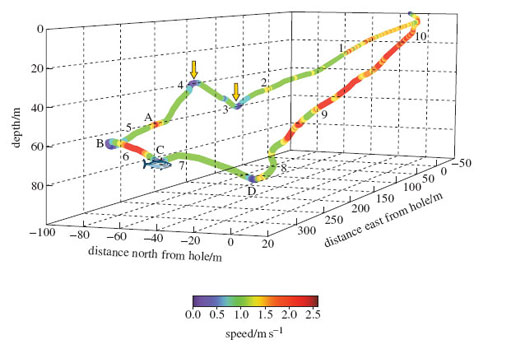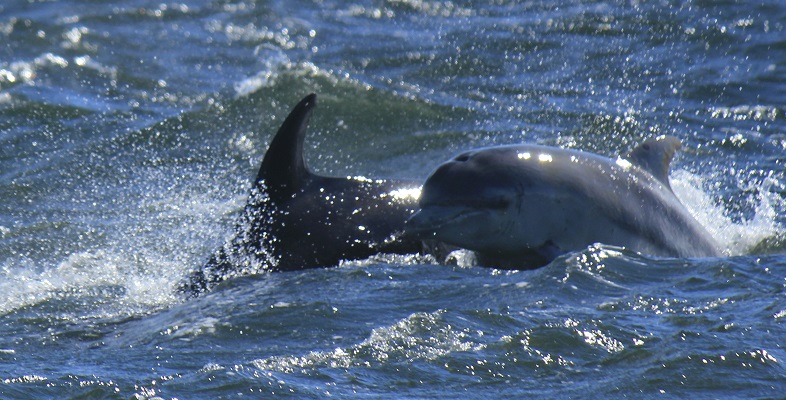3.2 Natural dives
The physiology of the diving response can be studied in the laboratory, but investigating the behaviour of a diving mammal in its natural environment can be more of a problem. However, modern physiological techniques have made it possible to record continuously physiological variables (such as heart rate) and information on depth and position during the spontaneous dives in the wild that are part of the animal’s normal behaviour. Most such findings show that the majority of an animal’s dives don’t approach the ‘Olympic record’ limits that represent maximum effort. For example, most Weddell seal dives were shorter than 20 minutes, and there is little evidence of profound adjustments in the heart and circulatory system during this time, or of the presence of lactic acid in the blood of these animals as they surface. Lactic acid is an important indicator of the onset of anaerobic metabolism (i.e. metabolism that doesn’t use oxygen). The production of lactic acid is a relatively inefficient way of releasing energy by the breakdown of simple sugars obtained from the diet. (In humans, lactic acid appears in the bloodstream during intense activity such as sprinting, when the supply of oxygen to the muscle cells isn’t sufficient to allow the oxidation of sugars in the ‘conventional’ way.)
Question 4
What do these observations suggest about the physiological events that accompany natural dives?
Answer
They suggest that a full-scale diving response is not typical of these shorter dives. If tissues were starved of oxygen, substantial levels of lactic acid would probably be evident in the blood, as anaerobic metabolism became established.
The implication is that in shorter dives, the amount of oxygen carried by the Weddell seal (mainly in the blood, as we’ve seen) is sufficient to tide the animal over, without a sustained or profound diving response. But with natural dives of 45 minutes or so, anaerobic metabolism becomes much more significant and the selective re-routing of blood (together with bradycardia) becomes much more important.
What about hunting behaviour? To continue the same example, the Weddell seal spends most of its time hunting cod and other fish out of sight beneath the Antarctic ice.
Marine biologist Terrie Williams and her colleagues at the University of California have studied the hunting behaviour of Weddell seals by attaching recording equipment to animals captured near their feeding holes. The seals are fitted with video and audio recorders, plus monitors that note the animals’ depth, speed, compass bearing and flipper strokes. The seals are then released back into the sea. The information that the scientists receive allows them to construct a three-dimensional map of the dive that is tied to specific pieces of behaviour recorded by the video camera. The seals hunt in low levels of light and have to find, stalk and catch their prey while holding their breath.

Figure 16 shows a dive by an adult female Weddell seal. The dive lasted for 10 minutes 30 seconds, and the animal travelled a total of 760 m. About midway through the dive, at point C, the video footage revealed that the seal attacked a large Antarctic cod, approaching from behind and below its tail. Let’s look at what happened in more detail.
The seal started the dive with a few powerful strokes of its flippers. Water pressure would have quickly collapsed its lungs, making the seal denser than the surrounding water. The negatively buoyant animal could then have continued its descent with little effort. (The team have discovered that in pinnipeds and cetaceans, this effortless gliding minimises the effort expended by the animal while submerged.) The seal sank slowly to a depth of 51 m (marked by the right arrow), rose slightly to a depth of 33 m (marked by the left arrow), and then started a new descent, maintaining roughly the same bearing and speed. This course was taking it in the general direction of the fish.
At point A, some 23 m from the fish, the seal used a few large flipper strokes to change direction and speed, accelerating away from the fish at an angle of 58 degrees to its previous course. It then used a looping turn (point B) to bring it back towards – but beneath – the fish. It accelerated again towards the target but slowed just before contact was made. After the attack had failed, the seal did not pursue the fish but continued its descent for a while, before turning left (point D) and proceeding quickly back to the ice hole.
Question 5
The data gathered can tell us a lot about what happened, but little about why. We are still left with the problem of interpreting the sequence. Try this for yourself. For example, why might the seal have moved away from the fish at point A?
Answer
Here is one interpretation (and it is difficult, if not impossible, to prove). It’s possible that the initial descents and ascents on a constant bearing were a searching strategy. At point A, the seal spotted the cod a short distance away (remember the poor light). If it approached the fish head-on it would be seen quite quickly. The turns at points A and B allowed the seal to attack the fish from behind and below.
After accelerating out of the second turn, it pulled its flippers to its side and coasted towards its prey, which accounts for the deceleration recorded just before contact. The seal would be camouflaged against the darkness of the deep water and the fish would be silhouetted against the ice.
Optional activity
If you find this topic interesting, you have the opportunity to find out more from the original scientific paper by Terrie Williams and her colleagues that reported these findings to the scientific world. The language used in the paper is sometimes technical and assumes some familiarity on the part of the reader with specialist terminology and the use of recording techniques. But you don’t need to understand it all to get something from the paper. It contains much more information than the signficantly abbreviated description above, outlining the reasons the research work was undertaken, and providing a fuller account of the three brief encounters – from 57.4 hours of recording! The broader significance of these findings is discussed, with an emphasis on what was new and unexpected about these observations, and the potential of the technique for revealing more about the hunting behaviour of diving mammals. Click the following link to view the paper.
Link to paper on hunting behaviour [Tip: hold Ctrl and click a link to open it in a new tab. (Hide tip)]